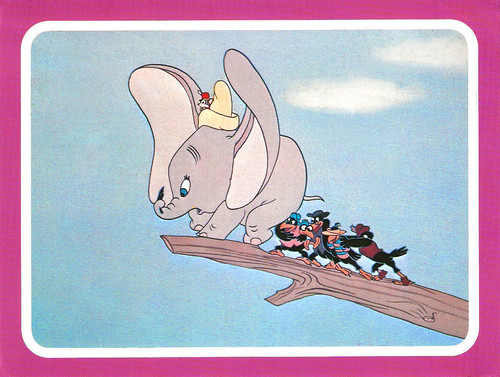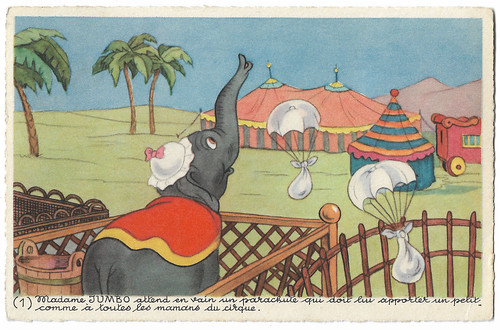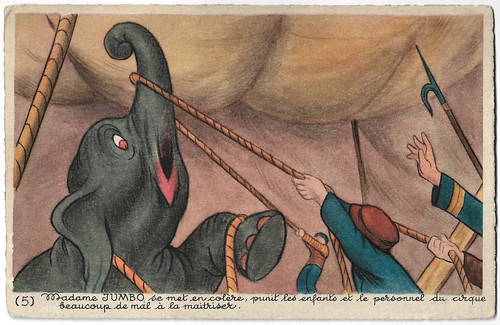It's Disney December at EFSP. Dumbo (1941) was Walt Disney's fourth animated feature and it's a masterpiece. Dumbo deals with discrimination, self-esteem, the importance of family, and friendship. For this post, we've found old French postcards of Dumbo, published in the 1940s by Éditions Superluxe in Paris, and some more recent postcards.

Big American postcard in the Walt Disney's Classics series by Classico, San Francisco, no. 511-021. Sent by mail in the Netherlands in 1983. Image: The Walt Disney Company. Publicity still for Dumbo (Ben Sharpsteen, a.o., 1941). Caption: Based upon an original story, Dumbo, the Flying Elephant, by Helen Aberson and Harold Pearl, the Disney feature starred a little circus elephant who never talked and his pal, Timothy Mouse, who talked for both of them. After mistakenly drinking some champagne that belonged to the clowns, the elephant and the mouse fell asleep and awoke to find themselves upon the limb of a tall tree with a flock of crows. "Your ears, Dumbo. Dere poifect wings. You flew!", exclaimed Timothy, and he persuaded the little elephant to do it again.

French postcard in the 'Le monde merveilleux de Walt Disney' series by Editions Kroma, Caisargues. Image: Walt Disney Productions. Publicity still for Dumbo (Ben Sharpsteen, a.o., 1941). Sent by mail in 1990.

French postcard by Éditions Superluxe, Paris, no. 1. Image: Walt Disney - Mickey-Mouse, S.A. Publicity still for Dumbo (Ben Sharpsteen, a.o., 1941). Caption: Mrs. Jumbo waits in vain for a parachute which should bring her a little one like all the mothers of the circus.

French postcard by Éditions Superluxe, Paris, no. 2. Image: Walt Disney - Mickey-Mouse, S.A. Publicity still for Dumbo (Ben Sharpsteen, a.o., 1941). Caption: But what a joyful surprise for Mrs. Jumbo when the stork comes to deposit a small stirring package in the wagon.

French postcard by Éditions Superluxe, Paris, no. 3. Image: Walt Disney - Mickey-Mouse, S.A. Publicity still for Dumbo (Ben Sharpsteen, a.o., 1941). Caption: The ugly gossips housed in the wagon laugh at Dumbo's huge ears much to Madame Jumbo's anger.

French postcard by Éditions Superluxe, Paris, no. 5. Image: Walt Disney - Mickey-Mouse, S.A. Publicity still for Dumbo (Ben Sharpsteen, a.o., 1941). Caption: Ms. Jumbo gets angry, punishes the children and becomes very hard to master for the circus staff.
Honestly, I've watched Dumbo (Ben Sharpsteen, a.o., 1941) more than a hundred times, together with my mentally handicapped son Lucas. The film still thrills us no matter how many times we have seen it.
Dumbo is based upon a children's story written by Helen Aberson-Mayer and Harold Pearl, with illustrations by Helen Durney, that was prepared to demonstrate the prototype of a toy storytelling display device called 'Roll-A-Book', which was similar in principle to a panorama. It involved only eight drawings and just a few lines of text.
Dumbo was first brought to the attention of Walt Disney in late 1939 by Disney's head of merchandise licensing Kay Kamen, who showed a prototype of the Roll-A-Book that included Dumbo. Disney immediately grasped its possibilities and heartwarming story and purchased the rights to it. Originally it was intended to be a short film, but Disney soon found that the only way to do justice to the book was to make it feature-length.
In the opening sequence, a flock of storks delivers babies while circus animals are being transported by train from their 'Winter Quarters'. Finally, a tired stork also delivers a baby elephant to Mrs. Jumbo, a veteran of the tough circus world. All the other elephants ridicule the newborn Jumbo Jr. for his gigantic ears. He is dubbed 'Dumbo' and is shut out.
After his mother has been locked up in a jail-like waggon for protecting him, Dumbo is all alone. Heartbreaking is the scene scene when Dumbo's mother in chains rocks him with her trunk from beyond the bars. Timothy Q. Mouse feels sympathy for Dumbo and appoints himself as Dumbo's mentor and protector. Timothy is determined to help Dumbo regain his spirits.
The circus director makes Dumbo the top of an elephant pyramid stunt. The performance goes awry as Dumbo trips over his ears and misses his target, causing the other elephants to suffer various injuries, and bring down the big top.
When Dumbo is relegated to the circus' clown acts, it is up to his only friend, Timothy, to assist the little elephant to achieve his full potential at last. Dumbo learns that he can fly and becomes he 'ninth wonder of the universe', and the only elephant in the world who can fly.

French postcard by Éditions Superluxe, Paris, no. 10. Image: Walt Disney - Mickey-Mouse, S.A. Publicity still for Dumbo (Ben Sharpsteen, a.o., 1941). Caption: Timothy, the nice little mouse consoles Dumbo of his woes and Dumbo is happy to have found a friend.

French postcard by Editions Superluxe, Paris, no. 12. Image: Walt Disney Productions. Publicity still for Dumbo (Ben Sharpsteen, a.o., 1941). Caption: Timothy has found a great role for Dumbo. He will have to jump from a springboard and come to plant a flag at the top of a pyramid of elephants.

French postcard by Editions Superluxe, Paris, no. 15. Image: Walt Disney Productions. Publicity still for Dumbo (Ben Sharpsteen, a.o., 1941). Caption: After his unfortunate exploits, Dumbo made up and costumed as a clown must jump from a house on fire.
At just 64 minutes, Dumbo (Ben Sharpsteen, a.o., 1941) is short and sweet. But it also contains some of Disney's best visual poetry. The style is elegant, vivid, and occasionally grotesque in ways that recall not only classic circus posters but also Paul Cadmus paintings and vintage 'New Yorker' cover art, as one of the IMDb reviewers observes.
Dumbo (Ben Sharpsteen, a.o., 1941) certainly has a hint of nostalgia. The film presents a rosy-hued portrait of old America but in the middle is a simple, tender story about acceptance and mother love.
Dumbo and his mother are both mute which means that their entire characters are created through their body language. You see all the emotions Dumbo is passing through. Mrs Jumbo rearing up and destroying the big top to protect her little son from taunting kids is an incredible scene.
These performances are triumphs of animation. The entire opening sequence, till the gossipy elephants start talking, plays out without words, and its like the best silent films: simply beautiful.
The other characters, both good and bad, are painted with broad, memorable strokes. The songs and score are flawless, and the show-stopping, nightmarish pink elephant sequence is brilliant. One of the most inventive animation sequences ever.
Ben Sharpsteen was the supervising director of Dumbo. Sequences were directed by Sam Armstrong, Norman Ferguson, Wilfred Jackson, Jack Kinney, Bill Roberts and (uncredited) by John Elliotte. Despite the advent of World War II, Dumbo proved to be the most financially successful Disney film of the 1940s.
Tim Burton released a live-action adaptation of the film earlier this year, but I won't go to the cinema to see the new version. This one is just perfect.

French postcard by Éditions Superluxe, Paris, no. 17. Image: Walt Disney - Mickey-Mouse, S.A. Publicity still for Dumbo (Ben Sharpsteen, a.o., 1941). Caption: The fire clowns remove the canvas and Dumbo falls into a tub of soap suds and once again the audience laughs at him.

French postcard by Editions Superluxe, Paris, no. 19. Image: Walt Disney Productions. Publicity still for Dumbo (Ben Sharpsteen, a.o., 1941). Caption: Mr. Crow wakes Timothy and he tells the story of Dumbo's woes.

French postcard by Éditions Superluxe, Paris, no. 20. Image: Walt Disney - Mickey-Mouse, S.A. Publicity still for Dumbo (Ben Sharpsteen, a.o., 1941). Caption: Mr. Raven gives Timothy a magic feather that will allow Dumbo to fly thanks to his big ears.

French postcard by Editions Superluxe, Paris, no. 22. Sent by mail in 1953. Image: Walt Disney Productions. Publicity still for Dumbo (Ben Sharpsteen, a.o., 1941). Caption: This is the big jump, Dumbo will fly? Timothy lodged in his hat is worried.

French postcard by Editions Superluxe, Paris, no. 23. Image: Walt Disney Productions. Publicity still for Dumbo (Ben Sharpsteen, a.o., 1941). Caption: Hurrah. Dumbo flies and his friends the crows encourage him.

Dutch postcard by Gebr. Spanjersberg, Rotterdam, Antwerpen. Image: Walt Disney Company / Grafiche Bondetti. Caption: Congratulations. Sent by mail in 1988.
Sources: Wikipedia and IMDb.

Big American postcard in the Walt Disney's Classics series by Classico, San Francisco, no. 511-021. Sent by mail in the Netherlands in 1983. Image: The Walt Disney Company. Publicity still for Dumbo (Ben Sharpsteen, a.o., 1941). Caption: Based upon an original story, Dumbo, the Flying Elephant, by Helen Aberson and Harold Pearl, the Disney feature starred a little circus elephant who never talked and his pal, Timothy Mouse, who talked for both of them. After mistakenly drinking some champagne that belonged to the clowns, the elephant and the mouse fell asleep and awoke to find themselves upon the limb of a tall tree with a flock of crows. "Your ears, Dumbo. Dere poifect wings. You flew!", exclaimed Timothy, and he persuaded the little elephant to do it again.

French postcard in the 'Le monde merveilleux de Walt Disney' series by Editions Kroma, Caisargues. Image: Walt Disney Productions. Publicity still for Dumbo (Ben Sharpsteen, a.o., 1941). Sent by mail in 1990.

French postcard by Éditions Superluxe, Paris, no. 1. Image: Walt Disney - Mickey-Mouse, S.A. Publicity still for Dumbo (Ben Sharpsteen, a.o., 1941). Caption: Mrs. Jumbo waits in vain for a parachute which should bring her a little one like all the mothers of the circus.

French postcard by Éditions Superluxe, Paris, no. 2. Image: Walt Disney - Mickey-Mouse, S.A. Publicity still for Dumbo (Ben Sharpsteen, a.o., 1941). Caption: But what a joyful surprise for Mrs. Jumbo when the stork comes to deposit a small stirring package in the wagon.

French postcard by Éditions Superluxe, Paris, no. 3. Image: Walt Disney - Mickey-Mouse, S.A. Publicity still for Dumbo (Ben Sharpsteen, a.o., 1941). Caption: The ugly gossips housed in the wagon laugh at Dumbo's huge ears much to Madame Jumbo's anger.

French postcard by Éditions Superluxe, Paris, no. 5. Image: Walt Disney - Mickey-Mouse, S.A. Publicity still for Dumbo (Ben Sharpsteen, a.o., 1941). Caption: Ms. Jumbo gets angry, punishes the children and becomes very hard to master for the circus staff.
The tough, tough circus world
Honestly, I've watched Dumbo (Ben Sharpsteen, a.o., 1941) more than a hundred times, together with my mentally handicapped son Lucas. The film still thrills us no matter how many times we have seen it.
Dumbo is based upon a children's story written by Helen Aberson-Mayer and Harold Pearl, with illustrations by Helen Durney, that was prepared to demonstrate the prototype of a toy storytelling display device called 'Roll-A-Book', which was similar in principle to a panorama. It involved only eight drawings and just a few lines of text.
Dumbo was first brought to the attention of Walt Disney in late 1939 by Disney's head of merchandise licensing Kay Kamen, who showed a prototype of the Roll-A-Book that included Dumbo. Disney immediately grasped its possibilities and heartwarming story and purchased the rights to it. Originally it was intended to be a short film, but Disney soon found that the only way to do justice to the book was to make it feature-length.
In the opening sequence, a flock of storks delivers babies while circus animals are being transported by train from their 'Winter Quarters'. Finally, a tired stork also delivers a baby elephant to Mrs. Jumbo, a veteran of the tough circus world. All the other elephants ridicule the newborn Jumbo Jr. for his gigantic ears. He is dubbed 'Dumbo' and is shut out.
After his mother has been locked up in a jail-like waggon for protecting him, Dumbo is all alone. Heartbreaking is the scene scene when Dumbo's mother in chains rocks him with her trunk from beyond the bars. Timothy Q. Mouse feels sympathy for Dumbo and appoints himself as Dumbo's mentor and protector. Timothy is determined to help Dumbo regain his spirits.
The circus director makes Dumbo the top of an elephant pyramid stunt. The performance goes awry as Dumbo trips over his ears and misses his target, causing the other elephants to suffer various injuries, and bring down the big top.
When Dumbo is relegated to the circus' clown acts, it is up to his only friend, Timothy, to assist the little elephant to achieve his full potential at last. Dumbo learns that he can fly and becomes he 'ninth wonder of the universe', and the only elephant in the world who can fly.

French postcard by Éditions Superluxe, Paris, no. 10. Image: Walt Disney - Mickey-Mouse, S.A. Publicity still for Dumbo (Ben Sharpsteen, a.o., 1941). Caption: Timothy, the nice little mouse consoles Dumbo of his woes and Dumbo is happy to have found a friend.

French postcard by Editions Superluxe, Paris, no. 12. Image: Walt Disney Productions. Publicity still for Dumbo (Ben Sharpsteen, a.o., 1941). Caption: Timothy has found a great role for Dumbo. He will have to jump from a springboard and come to plant a flag at the top of a pyramid of elephants.

French postcard by Editions Superluxe, Paris, no. 15. Image: Walt Disney Productions. Publicity still for Dumbo (Ben Sharpsteen, a.o., 1941). Caption: After his unfortunate exploits, Dumbo made up and costumed as a clown must jump from a house on fire.
Some of Disney's best visual poetry
At just 64 minutes, Dumbo (Ben Sharpsteen, a.o., 1941) is short and sweet. But it also contains some of Disney's best visual poetry. The style is elegant, vivid, and occasionally grotesque in ways that recall not only classic circus posters but also Paul Cadmus paintings and vintage 'New Yorker' cover art, as one of the IMDb reviewers observes.
Dumbo (Ben Sharpsteen, a.o., 1941) certainly has a hint of nostalgia. The film presents a rosy-hued portrait of old America but in the middle is a simple, tender story about acceptance and mother love.
Dumbo and his mother are both mute which means that their entire characters are created through their body language. You see all the emotions Dumbo is passing through. Mrs Jumbo rearing up and destroying the big top to protect her little son from taunting kids is an incredible scene.
These performances are triumphs of animation. The entire opening sequence, till the gossipy elephants start talking, plays out without words, and its like the best silent films: simply beautiful.
The other characters, both good and bad, are painted with broad, memorable strokes. The songs and score are flawless, and the show-stopping, nightmarish pink elephant sequence is brilliant. One of the most inventive animation sequences ever.
Ben Sharpsteen was the supervising director of Dumbo. Sequences were directed by Sam Armstrong, Norman Ferguson, Wilfred Jackson, Jack Kinney, Bill Roberts and (uncredited) by John Elliotte. Despite the advent of World War II, Dumbo proved to be the most financially successful Disney film of the 1940s.
Tim Burton released a live-action adaptation of the film earlier this year, but I won't go to the cinema to see the new version. This one is just perfect.

French postcard by Éditions Superluxe, Paris, no. 17. Image: Walt Disney - Mickey-Mouse, S.A. Publicity still for Dumbo (Ben Sharpsteen, a.o., 1941). Caption: The fire clowns remove the canvas and Dumbo falls into a tub of soap suds and once again the audience laughs at him.

French postcard by Editions Superluxe, Paris, no. 19. Image: Walt Disney Productions. Publicity still for Dumbo (Ben Sharpsteen, a.o., 1941). Caption: Mr. Crow wakes Timothy and he tells the story of Dumbo's woes.

French postcard by Éditions Superluxe, Paris, no. 20. Image: Walt Disney - Mickey-Mouse, S.A. Publicity still for Dumbo (Ben Sharpsteen, a.o., 1941). Caption: Mr. Raven gives Timothy a magic feather that will allow Dumbo to fly thanks to his big ears.

French postcard by Editions Superluxe, Paris, no. 22. Sent by mail in 1953. Image: Walt Disney Productions. Publicity still for Dumbo (Ben Sharpsteen, a.o., 1941). Caption: This is the big jump, Dumbo will fly? Timothy lodged in his hat is worried.

French postcard by Editions Superluxe, Paris, no. 23. Image: Walt Disney Productions. Publicity still for Dumbo (Ben Sharpsteen, a.o., 1941). Caption: Hurrah. Dumbo flies and his friends the crows encourage him.

Dutch postcard by Gebr. Spanjersberg, Rotterdam, Antwerpen. Image: Walt Disney Company / Grafiche Bondetti. Caption: Congratulations. Sent by mail in 1988.
Sources: Wikipedia and IMDb.
No comments:
Post a Comment